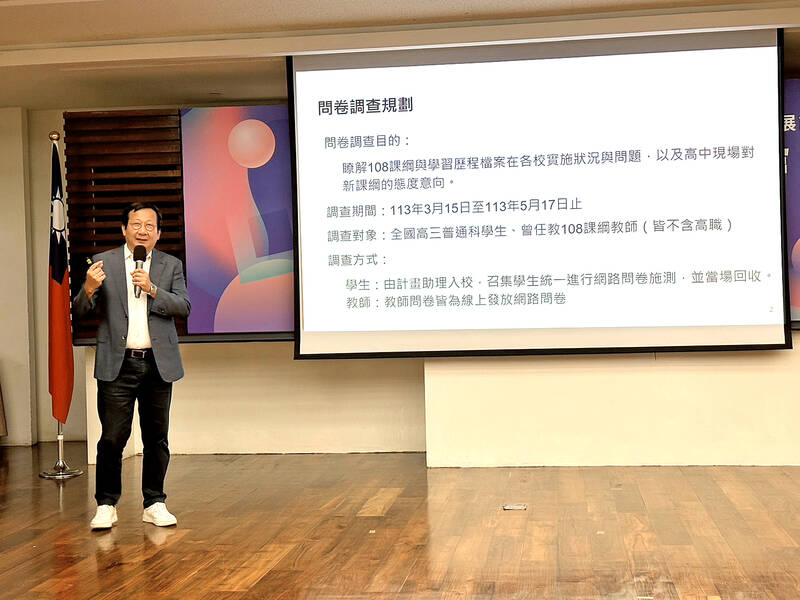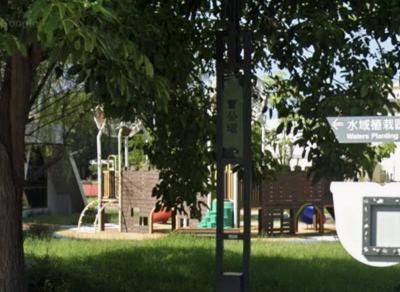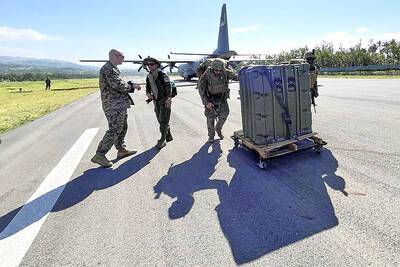Student learning portfolios can help universities make admissions decisions, but up to 5 percent of high-school students said they could not get help from teachers as they prepared them, academics said on Tuesday at a news conference arranged by the Ministry of Education.
The ministry’s curriculum guidelines released in 2019 for 12-year basic education require students to compile a portfolio of their learning outcomes over the three years of high school.
Since 2022, university applicants have been required to submit their portfolios.

Photo: Rachel Lin, Taipei Times
However, some students told education rights group EdYouth that their teachers refused to assist them, with their learning portfolios, causing concern among parents over children’s rights to apply to universities, two professors said.
Lin Kuo-ming (林國明), a professor in National Taiwan University’s Department of Sociology, last year conducted a survey of high-school students and high-school teachers nationwide, with a response rate of 76.39 percent among 2,825 students and 78.32 percent among 1,228 teachers.
About 5 percent of students said that their teachers were unhelpful with their learning portfolios, while 80 percent of teachers said they helped, Lin said.
The survey showed that 70.85 percent of teachers said they could not help due to tight schedules and overwhelming amounts of work, while 69.87 percent said they were uncertain whether the portfolios would matter to professors, Lin said, urging the ministry to write a policy to guide teachers regarding the matter.
Department of Higher Education Director-General Liao Kao-hsien (廖高賢) said that the ministry would collaborate with the Education Administration to prepare a policy and guide teachers to help students collate their portfolios.
Although some students believed the portfolios would give richer students an advantage over others, the research showed that less than 2 percent of students attended cram schools to polish up their portfolios, while satisfaction with their portfolios was not affected by the urban-rural divide, their parents’ occupations and their family’s social status, Lin said.
Eighty percent of teachers believed that producing a portfolio would help students develop abilities and explore their aspirations, while 90 percent of students reported acquiring a new skill from the work, he said.
Underprivileged students tended to believe that the portfolios helped them explore their aspirations and cultivate skills, he added.
The ministry said that it commissioned National Sun Yat-sen University (NSYSU) to research the opinions of professors who have reviewed written applications for admission to universities, with more than 3,300 surveyed every year.
The percentage of professors who read written applications at the second stage of the university admissions process has increased every year, said Shih Ching-lin (施慶麟), a professor in NSYSU’s Institute of Education.
Most professors review 31 to 60 written applications per year and spend about 14 minutes reading each application, Shih said.
Meanwhile, the National Federation of Teachers’ Unions suggested setting a deadline for uploading PDF files of the portfolios, a format allowed in the university admissions process.
Department of Higher Education head Kuo Chia-yin (郭佳音) said that the issue would be examined, with the needs of students of different backgrounds, such as those from experimental education providers, taken into account.
Additional reporting by CNA

A 72-year-old man in Kaohsiung was sentenced to 40 days in jail after he was found having sex with a 67-year-old woman under a slide in a public park on Sunday afternoon. At 3pm on Sunday, a mother surnamed Liang (梁) was with her child at a neighborhood park when they found the man, surnamed Tsai (蔡), and woman, surnamed Huang (黃), underneath the slide. Liang took her child away from the scene, took photographs of the two and called the police, who arrived and arrested the couple. During questioning, Tsai told police that he had met Huang that day and offered to

LOOKING NORTH: The base would enhance the military’s awareness of activities in the Bashi Channel, which China Coast Guard ships have been frequenting, an expert said The Philippine Navy on Thursday last week inaugurated a forward operating base in the country’s northern most province of Batanes, which at 185km from Taiwan would be strategically important in a military conflict in the Taiwan Strait. The Philippine Daily Inquirer quoted Northern Luzon Command Commander Lieutenant General Fernyl Buca as saying that the base in Mahatao would bolster the country’s northern defenses and response capabilities. The base is also a response to the “irregular presence this month of armed” of China Coast Guard vessels frequenting the Bashi Channel in the Luzon Strait just south of Taiwan, the paper reported, citing a

A total lunar eclipse, an astronomical event often referred to as a “blood moon,” would be visible to sky watchers in Taiwan starting just before midnight on Sunday night, the Taipei Astronomical Museum said. The phenomenon is also called “blood moon” due to the reddish-orange hue it takes on as the Earth passes directly between the sun and the moon, completely blocking direct sunlight from reaching the lunar surface. The only light is refracted by the Earth’s atmosphere, and its red wavelengths are bent toward the moon, illuminating it in a dramatic crimson light. Describing the event as the most important astronomical phenomenon

BETTER SERVICE QUALITY: From Nov. 10, tickets with reserved seats would only be valid for the date, train and route specified on the ticket, THSRC said Starting on Nov. 10, high-speed rail passengers with reserved seats would be required to exchange their tickets to board an earlier train. Passengers with reserved seats on a specific train are currently allowed to board earlier trains on the same day and sit in non-reserved cars, but as this is happening increasingly often, and affecting quality of travel and ticket sales, Taiwan High-Speed Rail Corp (THSRC) announced that it would be canceling the policy on Nov. 10. It is one of several new measures launched by THSRC chairman Shih Che (史哲) to improve the quality of service, it said. The company also said